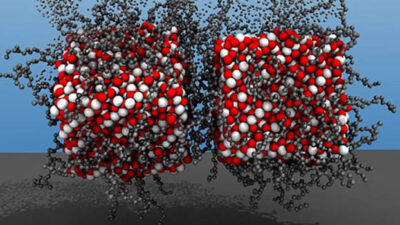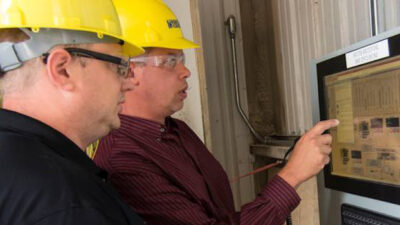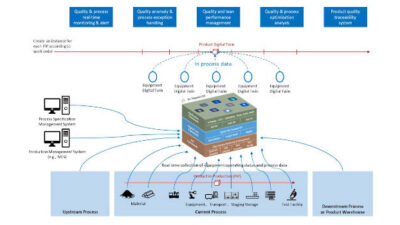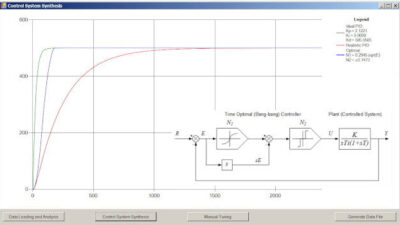Most of us interact with computers using our senses of sight and hearing. In some cases, however, the most appropriate sense to use is that of touch. Increasingly, computer technology is recognizing this today and incorporating haptic technology. Haptics, from the Greek meaning "to grasp or touch," refers to the ability of equipment to produce an output that is felt, rather than seen or heard.
Sidebars: Get in touch with haptics suppliers
AT A GLANCE
Emerging haptics technology
Sense of touch
Virtual reality
Increased accuracy
Limited but growing uses
Most of us interact with computers using our senses of sight and hearing. In some cases, however, the most appropriate sense to use is that of touch. Increasingly, computer technology is recognizing this today and incorporating haptic technology.
Haptics, from the Greek meaning “to grasp or touch,” refers to the ability of equipment to produce an output that is felt, rather than seen or heard. Haptic output is usually a force or vibration. How much force? “Our smaller devices produce 3-4 newtons [0.67 to 0.90 lb], and they go up to 30+ N [6.7+ lb] for some of the larger devices,” says Ben Landon, haptic devices and toolkits product-specialist, SensAble Technologies Inc.
Why haptics?
Two important applications for haptics are virtual reality (including games and medical training) and remote operation (or teleoperation). Although the possibilities in computer games are obvious, they exist in industry as well. For example, haptics allow users to touch and feel objects in CAD/CAM (computer-aided design/computer-aided manufacturing) and similar systems. Probes deliver digital feedback to design software, while all-electronic steering and braking gives operators or drivers realistic feedback, eliminating weight and complexity of direct or power-assisted mechanical connections.
Haptic technology in medical applications is a means of protecting patients from errors by providing “virtual” training for inexperienced staff. Haptic medical training systems can reproduce with startling reality the sensations of inserting a needle or a laparoscope while viewing results on the screen—and hearing the patient complain if it’s done incorrectly. It can be used for performing dental procedures, and more.
“The way doctors learn right now is pretty scary,” says Tom Anderson, CEO of Novint Technologies. “The first 50 times they do a procedure on a live patient, they’re learning.” Novint has an epidural simulator and a dental simulator that have received positive reviews from users. Michael Levin, vice president and general manager, industrial and gaming, Immersion Corp., reports that about 800 of his company’s vascular access platforms, which teach students how to insert an IV needle, are in use.
Haptics also is found in medical implant design, says Bob Steingart, president and COO, SensAble Technologies Inc. Data from a CT scanner are in the form of voxels (3-D or volumetric pixels). SensAble’s equipment uses the same format. “Imagine a person with a hole in his skull,” says Steingart. “You would start with a model coming off a CT machine, CAT scan, or MRI. The goal is to come up with a prosthetic that fills the hole. Using our system of voxels and virtual clay—and the skull model would also be voxels—you can come up with a very tight-fitting synthetic part very fast. The output is usually run to a rapid prototyping machine, or in some cases to a milling machine.”
Haptics can also be used to enhance data visualization, says SensAble’s Landon, allowing the user to navigate a sea of data (seismic imaging of rock strata, for example), and providing an additional communications channel. “You don’t have just color and time, you also have force feedback to help you to get an idea of what the data are like,” he says.
Knobs, mice, joysticks
Perhaps the simplest example of haptics is a knob, similar to one used for tuning a radio. By equipping the knob with a motor and brake, it is possible to have various types of detents, hard stops, and even elastic stops. And all these features can change as needed.
Haptic mice provide force, vibration, or both as software responses to user inputs. They are used in a wide range of applications, from games to physical therapy, and there is research underway on haptic mice as computer input devices for the blind. One problem with using a mouse in this way is that it must have some means of tracking absolute position; designs use rods or strings connected to a base.
Reverse robotics: handles in the air
In the realm of three-dimensional haptics is what amounts to “reverse robotics.” A robot allows the virtual world (software) to manipulate real objects. A haptic device allows a person to manipulate virtual objects and feel them as if they were real. For example, the user grips a handle (some systems use a glove or “thimble” device) connected to a system of arms.
A haptic touchscreen uses electromagnetic actuators in the screen corners to vibrate the touch overlay. (Image courtesy of Immersion Corp.).
There may be three degrees of freedom (3 DOF) that sense X, Y and Z axes, or six degrees of freedom (6 DOF) that also sense roll, pitch, and yaw. (Degree of freedom expresses the number of options available within a variable or space.) The system senses handle position and provides force and vibration to the user through built-in motors and brakes. When the cursor encounters a virtual object, the operator feels resistance, which may be hard (for a rigid object), soft, or elastic. When appropriate, the handle can vibrate to simulate, for example, what a user would feel when moving a stylus over a textured surface. Haptic gloves may be used in physical therapy to help stroke patients increase strength and improve function.
Researchers at Japan’s Toyohashi University of Technology have been studying the use of haptic joysticks for controlling cranes to avoid collisions. Work is underway in a number of places to add force feedback to surgical robots (which are really teleoperators). At the extreme low end of the size range, efforts are being made to integrate force dimension haptic devices with scanning electron microscopes to provide a sense of touch when manipulating nanoscale objects.
Touchscreen pushback
Most recently, haptics are being incorporated into touchscreens. Conventional touchscreens make it possible to place a control input anywhere on the surface of a screen, and haptics allows the user to actually feel them. Press a button and you’ll feel (and often hear) the button click. Virtual buttons can be any size or shape and anywhere on the screen. The way they respond to touch can be varied as well.
In December 2005, Volkswagen AG licensed Immersion’s haptic technology for use in automobile instrument panels. Instead of just feeling the hard surface of virtual control panels, drivers feel the buttons depress and release, just as physical buttons and switches do. In surveys, users given a choice of touchscreens with and without haptic feedback expressed a strong preference for the haptic feature, and if they could choose one only, they would prefer it to the alternative, according to Levin.
Sensations of touch can be produced in several ways. Perhaps the most direct would be to build an array of movable bumps into the display screen, so the surface actually takes on the desired shape. While this approach is effective, it is complicated and expensive. A simpler approach is to place an electromagnetic actuator in each corner of the screen to make controlled side-to-side movements in the touchscreen overlay (see graphic). Research has shown that the critical parameter is not distance but acceleration. Movements of only 0.1 to 0.2 mm are needed, making it possible to seal displays to NEMA 4 standards.
While haptics are gaining rapid acceptance in gaming and training applications, wider use for industrial applications may be slower. Simplifying the task of integrating haptics into the interface is one factor that would boost the use of this technology in industrial settings.
Most haptics companies offer an array of APIs (application program interfaces) and other software to aid development. Immersion Corp. is working on an integration kit with a small circuit board, a set of actuators, and a book of guidelines. The board comes with preprogrammed haptic effects; others can be downloaded and put into Flash. SensAble Technologies also offers haptic toolkits for its equipment.
A drop in costs will also drive the acceptance of haptics. At the lower end of the price range is Novint’s 3 DOF Falcon, which is intended to sell in the $150-200 range. While this unit is designed for consumer applications, experience has shown that some consumer electronics products find their way into industrial and commercial worlds relatively unchanged, and if they are manufactured and sold in retail consumer quantities the prices can be quite attractive. As for ruggedness, says Novint’s Anderson, this product “is designed in a way that people are going to be slamming it, and you want it to hold up over time, especially when people are playing video games with it, for example.”
SensAble’s Phantom Omni, a 6 DOF arm mounted to a base that can sit on a desktop, costs about $2,400 with the haptic toolkit software. On the touchscreen side, Immersion’s displays are available in sizes up to 19 inches, and the price of the haptic feedback unit is roughly equivalent to the price of the touchscreen.
Although still in its infancy, haptic technology appears to have a promising industrial future. And although the mouse may not become extinct—Novint named its Falcon for a bird of prey that eats mice—it may find it’s not the only species on the job.
Get in touch with haptics suppliers
For more information on haptics, visit the Websites of these suppliers:
Engineering Acoustics, Inc., Winter Park, FL,
FCS Robotics, Schiphol, Netherlands,
Force Dimension, Lausanne, Switzerland,
Immersion Corporation, San Jose, CA,
Novint Technologies, Albuquerque, NM,
Reachin Technologies, Stockholm, Sweden,
SensAble Technologies, Woburn, MA,



